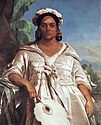Tahitians
|
|
|||||
| Total population | |||||
|---|---|---|---|---|---|
| (178,133 (on Tahiti, August 2007 census)) | |||||
| Languages | |||||
| Tahitian, French | |||||
| Religion | |||||
| Predominantly Calvinism, Roman Catholicism | |||||
| Related ethnic groups | |||||
| Hawaiians, Marquesans, Māori, Rapa Nui, Samoans and other Polynesian peoples | |||||
The Tahitians, or Maohis, are indigenous peoples of Tahiti and thirteen other Society Islands, as well as the modern population of these lands of mixed ancestry (French: demis). The Tahitians are one of the most significant indigenous Polynesian peoples of Oceania.
The original Tahitian society was unaware of metal as it was based on Stone Age technology. However, it enabled Tahitians to clear land for cultivation on the fertile volcanic soils and build fishing canoes, their two basic subsistence activities. The tools of the Tahitians when first discovered were made of stone, bone, shell or wood.
The Tahitians were divided into three major classes (or castes): ari'i,ra'atira and manahune.Ari'i were relatively few in number while manahune constituted the bulk of population and included some members who played essential roles in the society. It is estimated that by the first contact with Europeans in 1767 the population of Tahiti was no more than 40,000 while other Society Islands held probably 15,000-20,000 natives.
Tahitians divided the day into the periods of daylight (ao) and darkness (pō). There was also a concept of irrational fear called mehameha, translated as uncanny feelings. The healers, familiar with herbal remedies, were called ta'ata rā'au or ta'ata rapa'au. In the 19th century Tahitians added the European medicine to their practice. The most famous Tahitian healer Tiurai, of ari'i, died aged 83 during the influenza outbreak on Tahiti in 1918.
When British Captain Samuel Wallis "discovered" Tahiti on 18 June 1767, the natives were eager to trade, especially in iron nails unknown to them.Philibert Commerçon (1727–1773) in his The Tahitian Savage to the French wrote: "They have a fruit instead of bread. Their other foods are equally simple". Commerçon also described the practice of public sex, which he said Tahitians engaged in while being cheered on by applause and musical instruments. In the marital relationships Tahitians closely approached the situation where all women were the wives of men and the wife of every man was also the wife of his friend.Louis Antoine de Bougainville described a scene, where a young girl came on board, placed herself upon the quarter deck and carelessly dropt the cloth.Charles Darwin also wrote on Tahitians during the voyage on the Beagle: "There is a mildness in the expression of their countenances, which at once banishes the idea of a savage; and an intelligence, which shows they are advancing in civilization".
...
Wikipedia




